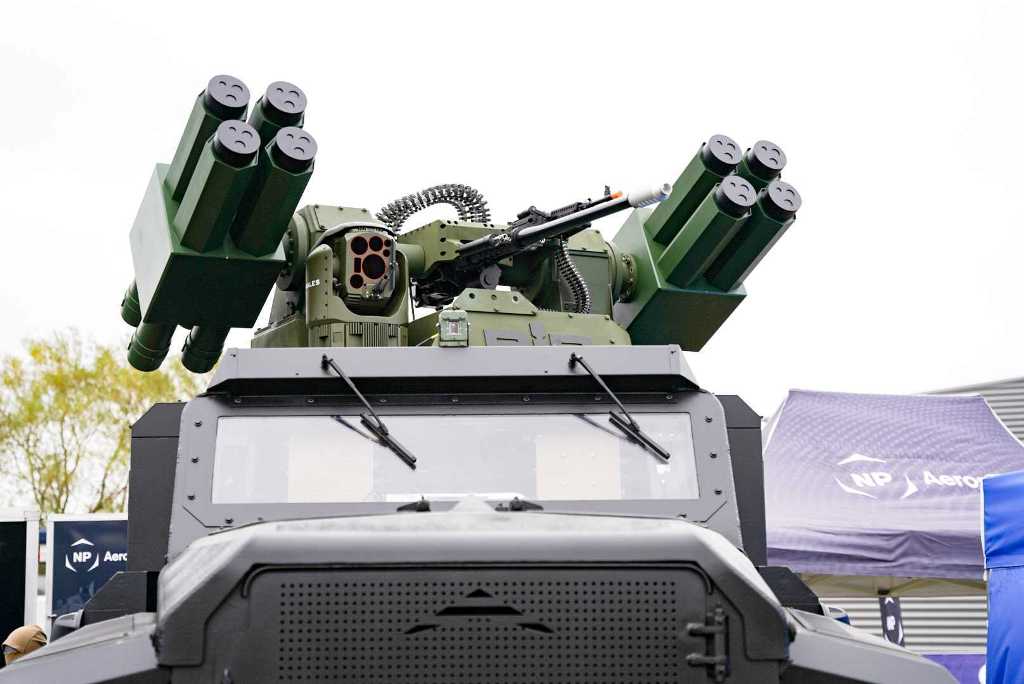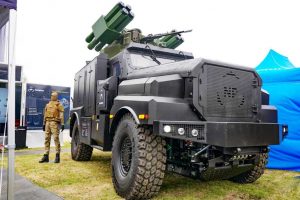
DVD 2024 – Moog’s RIwP reconfiguring lethality for the 21st Century
Moog UK, a leading manufacturer of turret stabilisation systems is working to bring its Reconfigurable Integrated-weapons Platform (RIwP – pronounced ‘rip’) to the UK in response to the country’s Ground Based Air Defence (GBAD) requirements. EDR On-Line met with Richard Allen-Miles, Moog’s EMEA Capture Lead, and Col (Retd) Doug White, Moog’s RIwP Business Development Manager, to learn more about the RIwP at DVD 2024, and understand why it is much more than just a turret.
RIwP is a stabilised pedestal that is designed so that it can be reconfigured with almost any medium weight weapon and fitted to an armoured vehicle. The intent behind the design is that a user should be able to change the weapons carried by the RIwP depending on the threat. Dealing with a Russian battalion tactical group, then carry a mix of anti-armour and air defence missiles. Focused on counter-UAS capabilities, reconfigure the system with a medium cannon and missiles. This is the guiding principle behind the RIwP and a key element of what makes it different to a regular turret.
The UK has two requirements for SHORAD, one is aimed at providing point defence against fixed and rotary wing targets, the other is essentially counter-UAS, or counter small aerial targets (C-SAT) as the British Army refers to it. Moog is proposing RIwP armed with the now proven M230 LF, a 30 mm cannon chambered to fire the 30×113 mm round, which is in service on the US Army’s Maneuver-SHORAD vehicle as well as its MLIDS solution, a two-vehicle C-UAS system, Doug White explained. The M230 fires the XM1211 proximity fused airburst round, which is an important advance in kinetic counter-UAS systems as the rounds only need to get near to a target. Typical airburst munitions are programmed at the breech of the gun, which means they explode when they are programmed to, even if the target has moved.
A cannon would be sufficient for the C-SAT programme, and this has been indicated as a requirement by the British Army, however, RIwP would provide the capability to upgrade to a cannon plus missiles if the requirement emerged. “It makes sense to build for change, the UK wants the High Velocity Missile (HVM) for its SHORAD requirement, which we can mount on RIwP,” Allen-Miles told EDR On-Line. “However, it’s an expensive missile, and it’s not always suitable for every target, whereas HVM with M230 would provide layered air defence on a single vehicle.”

“Take M-SHORAD as an example, when it first started, it carried the M230 LF, four Stinger missiles and two Hellfires,” White said, “but if you see the vehicles now, they are armed with two pods of four stingers, that reconfiguration was very straightforward because the RIwP is already built to carry Stinger. So, we build the new pods and add them to the weapon platform,” he added.
This was possible because the M-SHORAD solution was built to carry Stinger, so the wiring and software needed to make it work were in place from the beginning. “If a RIwP is built for but not with a missile, you could add that missile in about three hours at an operational level – by that I mean, in the field,” White said.
“We can add a brand new missile with all of the wiring and interfaces required, as well as test firing in 6 – 9 months,” Allen-Miles added. “Alternatively, if the British Army knows or thinks it might like to add a new missile in the future, we could build the RIwP to carry that missile from the start, then they could just install it when the time is right,” he said. Moog is also considering the RIwP as an entrant for the UK’s Battle Group Organic Anti-Armour programme, for which it could be fitted with four Brimstone missiles.
Like many of the companies at DVD 2024, Moog is conscious of the need to build the RIwP in the UK if it is to be successful. The company already has an established presence in the UK, with products on Ajax, Warrior, and Challenger 2. It is in the advanced stages of planning to manufacture the RIwP entirely in the UK.
At DVD 2024, the British Army has presented elements of its Land Operating Concept, which includes the goal of manoeuvring with confidence and striking deep into an opponent’s operational structure. Effective SHORAD will be essential to achieving Russian attack helicopters like the Ka-52 have been used to deadly effect in Ukraine. Their 9M120 Ataka missiles and high speed have enabled them to inflict significant casualties on Ukrainian armour as it attempts to manoeuvre. Equally, the ubiquitous small UAS is an ever-present danger to armoured formations as are the larger reconnaissance-strike platforms like the Lancet-3M. The Ka-52 is the type of target that HVM was designed to counter, however, Lancet may prove more challenging for that weapon, and easier to intercept with an airbursting round like the XM1211. This is one element of the SHORAD challenge and the complexity involved in ensuring the defence of armoured units as they move about the battlefield.
However, with changes to the UK’s government, many procurement decisions remain on hold, while the threat from Russia and its partners is growing. This could lead to time-pressured decision-making. The capabilities of RIwP, and the threat represented by the current suite of adversaries indicate that it would be wise to give the British Army time to make a selection and properly test the products available to it.
Photos courtesy Moog



